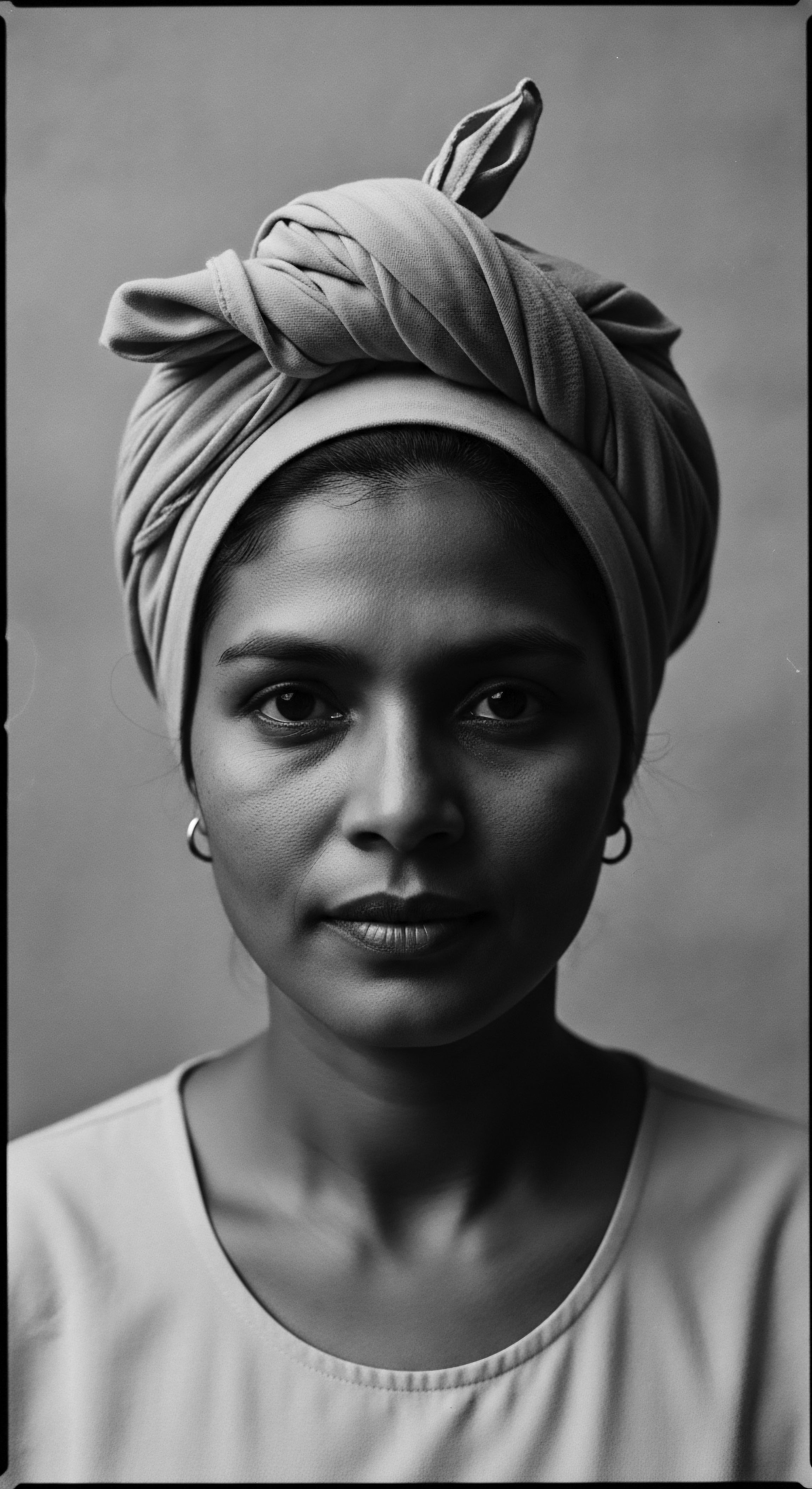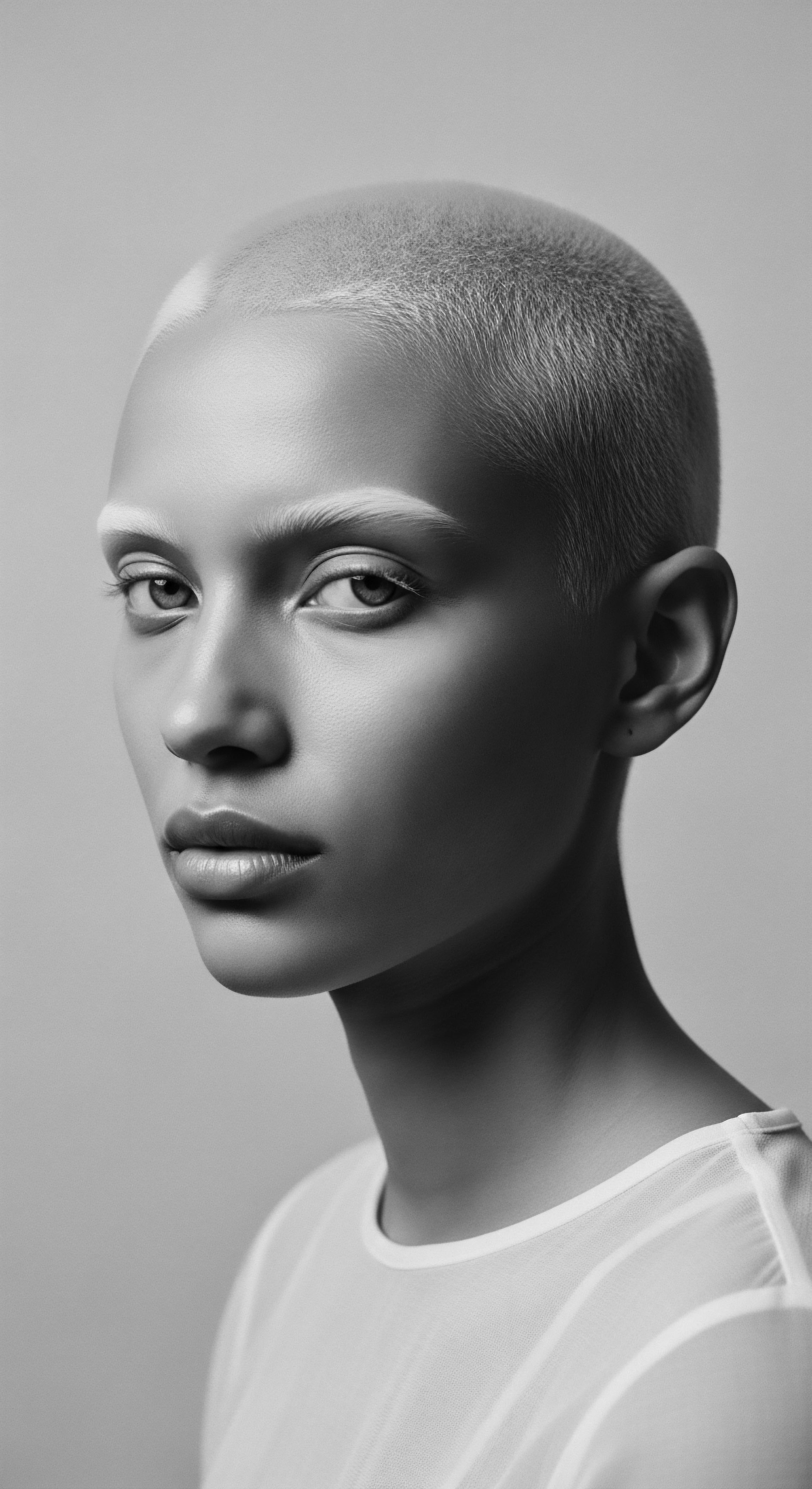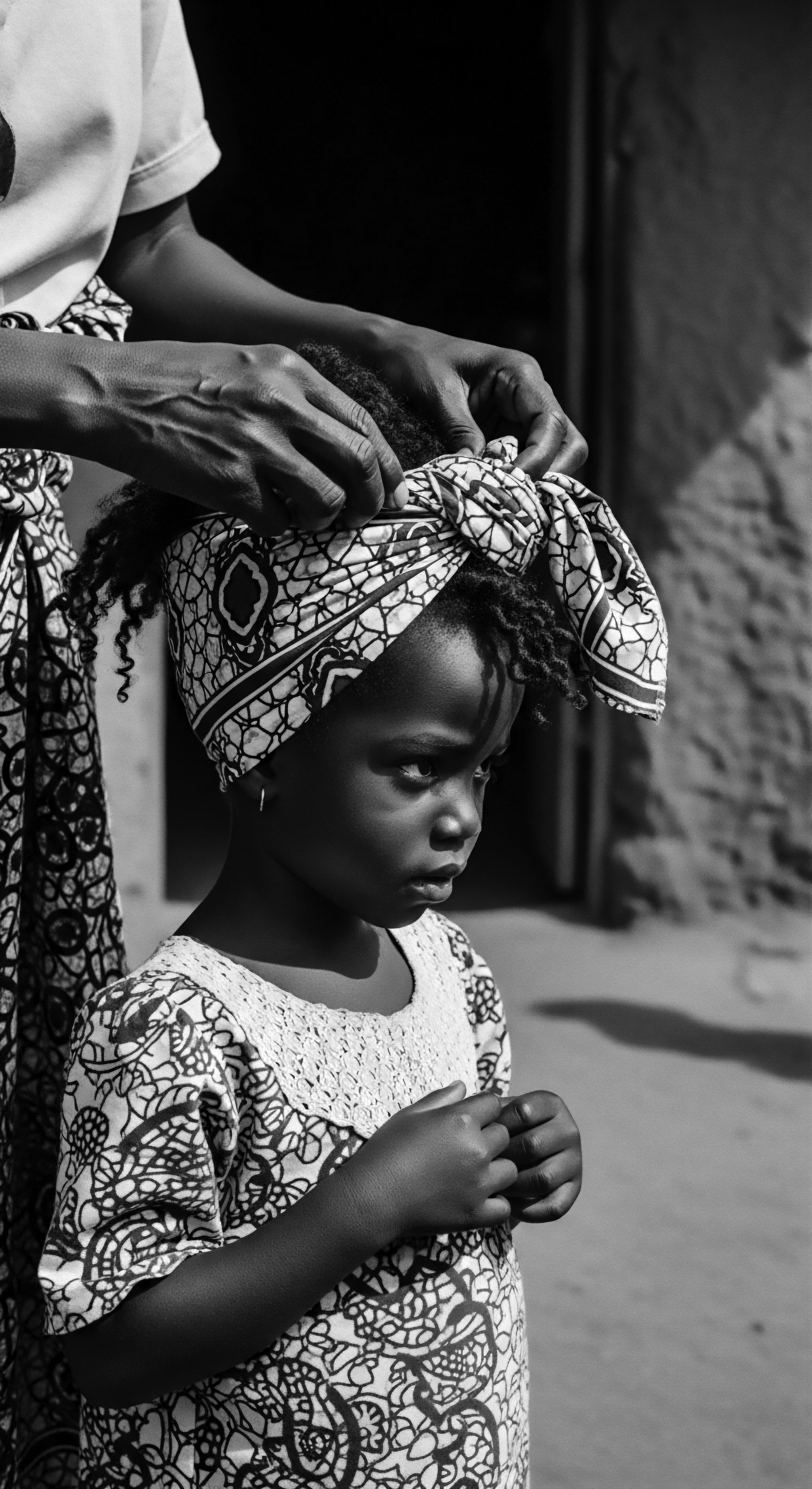
Fundamentals
The sleep bonnet, at its heart, represents a dedication to safeguarding hair during slumber, a quiet ritual carried out in the stillness of the night. This seemingly simple garment, often crafted from smooth, gentle materials like silk or satin, forms a protective sheath around the hair, preserving its integrity against the friction and moisture absorption that can occur with conventional pillowcases. Its foundational purpose involves maintaining hair’s inherent structure, reducing tangles, and minimizing breakage, particularly for delicate strands that require constant vigilance against environmental stressors.
Understanding the sleep bonnet’s core function involves recognizing the inherent vulnerabilities of hair, especially textured and coily types, when exposed to abrasive surfaces throughout the night. Cotton pillowcases, for example, possess fibers that, under magnification, reveal a rough, porous texture. These minute protuberances, when combined with the constant movement of a sleeping head, act as tiny snags, disrupting the hair cuticle and drawing moisture away from the strand.
The sleep bonnet, by creating a smooth barrier, mitigates these mechanical assaults, allowing hair to retain its natural oils and moisture, thus promoting a healthier appearance and tactile sensation upon waking. This simple act of protection, therefore, becomes a testament to conscious hair preservation.
The sleep bonnet acts as a guardian, shielding delicate hair from nocturnal friction and moisture loss, a practice echoing ancient protective traditions.

The Practicality of Preservation
The practical utility of the sleep bonnet extends beyond mere surface protection. It plays a significant role in extending the life of intricate hairstyles, whether braids, twists, or straightened looks, preventing them from unraveling or flattening prematurely. For those who invest time and artistry in their hair, the bonnet allows for a refreshing wake-up, with styles largely intact, requiring minimal restyling. This aspect significantly reduces daily manipulation, a key factor in diminishing wear and tear on fragile hair.
Furthermore, the bonnet keeps hair neatly contained, preventing strands from falling across the face during sleep, which can contribute to skin breakouts by transferring oils and products. It is a tool for systemic hair care, one that quietly works to support the hair’s vitality with each passing night.

Ancestral Echoes in Daily Care
While modern iterations of the sleep bonnet boast sophisticated materials, the practice of covering and protecting hair during rest holds deep ancestral resonance. Across diverse cultures, particularly those with a history of intricate hair practices, head coverings were not merely adornments or symbols; they were often functional necessities for maintaining hygiene, protecting against elements, and preserving styles, which could take hours, if not days, to create. The instinct to safeguard the hair’s condition, to keep it pristine and healthy, finds its roots in communal knowledge passed down through generations. These early forms of head coverings, whether fashioned from woven fabrics or animal skins, represented an early understanding of hair’s fragility and the necessity of its preservation, laying the groundwork for what we now understand as the sleep bonnet.

Intermediate
The intermediate explanation of the sleep bonnet progresses beyond its rudimentary utility, probing into the specific material sciences that enhance its effectiveness and connecting these principles to the enduring wisdom of traditional hair care practices. Its significance becomes more apparent when one considers the microscopic interaction between hair strands and various textiles. Textured hair, by its very architecture, tends to be drier than straight hair due to the elliptical shape of its follicle, which makes it harder for natural oils to travel down the shaft. This inherent dryness makes it particularly vulnerable to moisture depletion and mechanical damage, rendering protective measures like the sleep bonnet indispensable.

The Science of Gentle Guarding
At an intermediate level of comprehension, the distinction between various bonnet materials becomes paramount. Silk, often lauded as the premier choice, is a protein-based fiber with a remarkably smooth surface. Its tightly woven structure presents minimal friction against the hair cuticle, thereby preventing breakage, split ends, and tangles. Beyond its low-friction properties, silk is a poor absorber of moisture.
This means that the natural oils and any conditioning treatments applied to the hair remain within the strands, rather than being drawn into the fabric, which is a common occurrence with absorbent materials like cotton. This moisture retention is vital for hair hydration, promoting suppleness and minimizing frizz, particularly for coily and kinky textures prone to dryness.
Satin, while often confused with silk, refers to a weave, not a fiber. Typically made from synthetic materials like polyester, satin possesses a smooth, glossy surface due to its specific weaving technique. This smoothness offers similar friction-reducing benefits to silk, making it a highly accessible and effective alternative for hair protection.
While satin may absorb slightly more moisture than natural silk, its smooth surface still provides a significant advantage over cotton, acting as a crucial barrier against the nightly attrition of hair. The conscious selection of such materials for sleep bonnets reflects an informed approach to preserving hair health, recognizing the specific needs of different hair textures and their environmental interactions.
The choice of silk or satin for a sleep bonnet reflects an advanced understanding of hair’s needs, minimizing friction and maximizing moisture retention.
Consider a practical demonstration of material differences:
| Material Type Cotton |
| Fiber Origin Natural (plant-based) |
| Surface Texture (Microscopic) Rough, porous |
| Moisture Absorption High |
| Friction Reduction Low (high friction) |
| Common Ancestral Analogues/Practices Historically used for general head coverings, but less ideal for hair preservation during sleep due to absorbency. |
| Material Type Satin (Polyester) |
| Fiber Origin Synthetic (petroleum-based) |
| Surface Texture (Microscopic) Very smooth (weave-dependent) |
| Moisture Absorption Moderate to low |
| Friction Reduction High |
| Common Ancestral Analogues/Practices Adaptation of smooth fabrics for ceremonial or protective wraps, where material properties for sheen were noted. |
| Material Type Silk |
| Fiber Origin Natural (protein fiber) |
| Surface Texture (Microscopic) Extremely smooth, fine |
| Moisture Absorption Very low |
| Friction Reduction Very high |
| Common Ancestral Analogues/Practices Ancient knowledge of animal fibers for softness and sheen, utilized in elite garments and possibly hair wraps for noble classes. |
| Material Type The nuanced selection of sleep bonnet materials today builds upon centuries of observations regarding fabric characteristics and hair's needs. |

From Survival to Sacred Ritual
The evolution of the sleep bonnet, from a rudimentary protective covering to a consciously chosen tool, mirrors a larger cultural trajectory of hair care within communities of Black and mixed-race heritage. In many ancestral African societies, hair held profound spiritual, social, and aesthetic significance. Protective styling and covering were integral to maintaining this sacred connection, often indicating marital status, age, community role, or rites of passage. The nocturnal protection of hair, therefore, was not a mere afterthought; it was a continuation of daily reverence for one’s crowning glory.
The materials might have been different, fashioned from bark, woven grasses, or finely spun textiles, yet the core meaning—the preservation of hair’s vitality and integrity—remained consistent. This historical continuity allows us to see the modern sleep bonnet not as a new invention, but as a renewed expression of an ancient, deeply rooted practice of reverence and preservation.
This intermediate understanding of the sleep bonnet invites a deeper appreciation for its origins and its scientific underpinnings, allowing individuals to make informed choices about their hair care practices. It is a bridge connecting ancestral wisdom with contemporary scientific explanations, solidifying its standing as an indispensable aid in the maintenance of textured hair health.

Academic
From an academic lens, the sleep bonnet transcends its designation as a mere accessory; it stands as a significant artifact within the continuum of haircare technologies, deeply intertwined with the cultural anthropology of Black and mixed-race hair, the physiological properties of hair fibers, and the socio-historical narratives of identity and self-preservation. Its meaning, in this comprehensive scope, signifies a deliberate intervention against environmental and mechanical stressors that disproportionately affect textured hair, while simultaneously serving as a tangible link to ancestral practices of bodily care and communal resilience. This elucidation requires drawing upon trichology, material science, and the critical examination of diasporic beauty standards.

The Unbound Helix ❉ A Definitional Tapestry
The sleep bonnet, in its fully realized academic definition, is a specialized, often conical or spherical, head covering designed with an exceptionally low coefficient of friction, typically achieved through the application of silk or satin weaves, which encapsulates the entire coiffure during nocturnal rest. Its fundamental intention is to mitigate the deleterious effects of shear stress and desiccation exerted by conventional bedding materials on the hair shaft, thereby preserving moisture content, maintaining structural integrity, and extending the longevity of styled hair, particularly in individuals possessing highly porous or intrinsically dry hair phenotypes. The delineation of its purpose extends into the realm of psycho-social well-being, where its usage becomes an act of self-care, cultural affirmation, and an expression of aesthetic autonomy within communities where hair has historically been politicized and subjected to scrutiny. This is not simply about safeguarding strands; it is about protecting a legacy.

Echoes from the Source ❉ Hair, Identity, and Resilience Through Time
To grasp the profound meaning of the sleep bonnet, one must trace the historical trajectory of Black and mixed-race hair, a journey marked by both profound reverence and systemic oppression. In numerous pre-colonial African societies, hair served as a sophisticated visual language, communicating tribal affiliation, social status, marital availability, and spiritual devotion. Head coverings, therefore, were not incidental.
They were integral to maintaining the sanctity and dignity of these elaborate coiffures, safeguarding them from dust, sun, and the rigors of daily life. The care taken to preserve hair, often through nocturnal coverings made of various natural fibers, was a direct extension of self-respect and communal pride.
The transatlantic slave trade, however, violently disrupted these ancestral practices, forcing enslaved Africans to adapt their hair care under conditions of extreme deprivation. Yet, even in such brutal circumstances, the instinct to protect and maintain hair persisted, becoming a clandestine act of resistance and a quiet assertion of identity. While the silk bonnet as we know it today did not exist, enslaved individuals and their descendants often repurposed readily available materials—pieces of cloth, salvaged garments—to cover and protect their hair at night.
This resourcefulness underscored a persistent cultural value placed on hair health, an unbroken thread of care that transcended unimaginable adversity. These improvised coverings, while functionally different from modern bonnets, carried the same profound intention ❉ to shield and preserve.
The sleep bonnet embodies a legacy of hair protection that persisted through historical adversity, a quiet act of cultural affirmation.
A powerful, yet less commonly cited, example of this resilience can be observed in the early 20th century, following the Great Migration in the United States. As Black women moved from the rural South to urban centers, they encountered new social norms and limited access to specialized hair products. Despite these challenges, communities established informal networks, often within homes or local churches, where knowledge of hair care, including the art of wrapping and protecting hair at night, was meticulously shared. Dr.
Ayana Byrd and Lori Tharps, in their comprehensive work Hair Story ❉ Untangling the Roots of Black Hair in America, document the ingenious adaptations employed by Black women to preserve their coiffures, often using scarves and cloths meticulously tied to prevent damage and extend the life of styles. They cite instances where communal knowledge, rather than commercial products, became the primary mechanism for transmitting essential hair preservation techniques. (Byrd & Tharps, 2001). This collective wisdom, passed down through oral traditions and practical demonstration, highlights how nocturnal hair protection was deeply woven into the fabric of Black women’s daily routines, not merely as a cosmetic endeavor, but as a practical necessity and a quiet act of self-care against a backdrop of systemic challenges. The contemporary sleep bonnet thus inherits this rich tradition of adaptive and communal care.

The Tender Thread ❉ Scientific Resonance with Ancestral Ingenuity
Modern trichology and material science provide a compelling validation of these ancestral practices. The structural morphology of textured hair—characterized by its elliptical cross-section, numerous twists and turns along the shaft, and often a higher cuticle count—renders it inherently susceptible to moisture loss and mechanical stress. The cuticular layers, which serve as the hair’s protective outer sheath, are more prone to lifting and damage when exposed to friction. Conventional cotton pillowcases, with their hygroscopic properties and rough fibers, exacerbate this issue, acting as microscopic abrasives and wicks, stripping hair of vital lipids and water.
Silk (a natural protein fiber, primarily fibroin) and satin (a weave often using synthetic polymers like polyester or nylon) offer a stark contrast. Their exceptionally smooth surfaces drastically reduce the coefficient of friction, minimizing cuticle abrasion and preventing the microscopic snags that lead to breakage and frizz. Furthermore, silk’s low absorbency ensures that the hair’s natural sebum and applied conditioning agents remain on the hair shaft, reinforcing its natural moisture barrier.
This scientific understanding elucidates the empirical wisdom that led ancestral communities to seek out smooth, protective coverings for their hair, recognizing their benefits long before the advent of scanning electron microscopes. The enduring wisdom of ancestral approaches, often centered on material properties and meticulous care, finds intriguing echoes and expansions in our contemporary scientific comprehension, revealing a continuous thread of hair understanding.
Consider the biochemical effects of friction on the hair shaft:
- Cuticle Integrity ❉ The outermost layer of the hair, the cuticle, comprises overlapping scales. Friction causes these scales to lift and abrade, exposing the inner cortex, leading to porosity and susceptibility to environmental damage.
- Moisture Balance ❉ When cuticles lift, hair loses moisture at an accelerated rate, becoming dry, brittle, and prone to breakage. Smooth surfaces help maintain a sealed cuticle, locking in hydration.
- Protein Degradation ❉ Mechanical stress can lead to the degradation of keratin proteins within the hair fiber, compromising its strength and elasticity over time. The sleep bonnet acts as a physical buffer against such forces.
The sleep bonnet, therefore, serves as a sophisticated biotechnological intervention, leveraging principles of surface science to counteract the inherent vulnerabilities of textured hair. Its design principles align with a deep, intuitive understanding of hair physiology, translating into tangible benefits for hair health.

Beyond the Veil ❉ The Sleep Bonnet as a Cultural Nexus
The sleep bonnet occupies a significant position at the nexus of aesthetics, health, and cultural identity. Its use in contemporary Black and mixed-race communities is not merely a cosmetic choice; it is a declaration of self-possession and a continuation of an inherited legacy of care. The act of donning a bonnet signifies an intentional commitment to hair wellness, a form of active maintenance that counters historical narratives of hair neglect or devaluation. For many, it symbolizes a private ritual of preservation, distinct from the public performance of hair, offering a space where hair is honored in its natural state, free from the pressures of external scrutiny.
This seemingly unassuming garment also plays a role in challenging dominant beauty paradigms, which historically marginalized textured hair. By protecting natural hair, the bonnet facilitates its healthy growth and encourages the wearer to embrace their intrinsic curl patterns and textures. It is a tool that supports hair liberation, freeing individuals from the cycle of damage and excessive styling, allowing for an authentic expression of self.
The sleep bonnet, therefore, acts as a silent advocate for ancestral beauty, enabling the continuation of practices that honor and safeguard the unique heritage of textured hair, ensuring its vitality for generations to come. From the generational hearths where meticulous care was the revered method for nurturing hair in the context of sleep, a legacy of embodied knowledge unfolds, now gently illuminated and often affirmed by modern scientific insights, allowing us to appreciate the unbroken lineage of care surrounding hair protection.

Reflection on the Heritage of Sleep Bonnet
The journey of the sleep bonnet, from its elemental biological necessity to its status as a revered cultural artifact, casts a long, resonant shadow across the landscape of textured hair heritage. It stands not merely as a functional item, but as a quiet sentinel of ancestral wisdom, a testament to the enduring human spirit’s capacity for resourcefulness and self-preservation. This seemingly simple piece of fabric carries within its threads the whispers of generations who understood, long before microscopes revealed cellular structures, the profound value of protecting one’s crowning glory. It embodies a continuous dialogue between the ancient understanding of hair’s inherent nature and the contemporary scientific validation of practices forged in necessity and love.
The bonnet’s continued presence in daily rituals, particularly within Black and mixed-race communities, speaks to a heritage that views hair not as a superficial adornment, but as a living extension of identity, a repository of stories, and a connection to lineage. It is a quiet rebellion against histories that sought to diminish the beauty and dignity of textured hair, transforming a simple act of protection into a profound declaration of self-worth and cultural pride. This enduring legacy reminds us that the tending of hair is, at its heart, a tender thread woven through time, connecting us to those who came before and paving the path for those who will follow. The sleep bonnet, in its profound simplicity, therefore remains a vibrant symbol of resilience, beauty, and the unending soul of a strand.

References
- Byrd, Ayana D. and Lori L. Tharps. Hair Story ❉ Untangling the Roots of Black Hair in America. St. Martin’s Press, 2001.
- Gordon, Edmund W. and Brenda J. Allen. Black Hair ❉ Art, Culture, and Politics. Routledge, 2021.
- Akbar, Na’im. Chains and Images of Psychological Slavery. New Mind Productions, 1984.
- Banks, Ingrid. Hair Matters ❉ Beauty, Power, and the Politics of African American Women’s Hair. NYU Press, 2000.
- Mercer, Kobena. Hair ’05 ❉ Cultural History of Hair and Identity. The MIT Press, 1994.
- Bundles, A’Lelia. On Her Own Ground ❉ The Life and Times of Madam C.J. Walker. Scribner, 2001.
- Johnson, Victoria L. Hair Management ❉ African American Women and the Politics of Hair Care. University of North Carolina Press, 2012.
